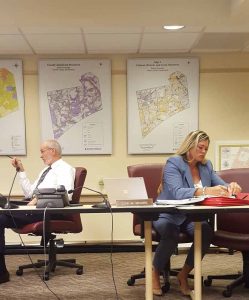By Eliza Mohler, Staff Writer, The Times

Kennett Township Board of Supervisors Chairman Scudder Stevens listens to residents’ concerns about environmental practices at the Sinclair Springs project site while Township Manager Lisa Moore checks permit records.
KENNETT – Over the course of a frequently terse conversation, the township’s Board of Supervisors agreed to reconsider the role of the township’s environmental advisory council (EAC).
EAC chairperson Matt Sabo and member Dave Lewis addressed the board during the October 4 meeting, saying that some residents had come to the EAC with concerns about the treatment of the environment by the developers of the Sinclair Springs subdivision project on Hillendale Road, including the unsanctioned removal of a heritage tree from the project site.
Sabo, whose background is in environmental consulting and education, asked the board to consider allowing the EAC to meet with the township engineer every two months to review the engineer’s recommendations and to discuss potential discrepancies between residents’ and the engineer’s observations about the project developer’s compliance with the conditions of the approved plan.
Sabo also mentioned that some residents who had approached the EAC feel that the township has been less transparent about planning approval process for the Sinclair Springs project. Supervisor Whitney Hoffman replied, “Hearing that people are concerned about the transparency is very concerning to me.” She then asked Sabo for concrete examples, but he declined because he said everything he heard is third hand, since he wasn’t directly involved in the planning process.
Lewis and Sabo presented the board with photos Lewis had taken of an area of the site that has what they claim is an impounded stream, which the township engineer had previously told Sabo was not impounded. This and other concerns about the Sinclair Springs project prompted Sabo to make the request.
Sabo’s request was met with resistance from Chairman Scudder Stevens, who said he did not support any suggestion that the EAC should oversee the work of the township engineer. Stevens and Hoffman said that they encourage residents to bring any concerns or questions to the attention of the supervisors. Allowing the EAC to review the engineer’s work and recommendations goes beyond its mandate, Stevens added.
Stevens also argued that questions about supposed discrepancies and questionable work practices on the project were more likely misunderstandings, such as a culvert that Sabo and Lewis thought might not have been installed turning out to have been installed at a point after they started asking about it.
As another example, Lewis found that a permit the developer needed was not registered publicly online and at least one state official he called had seen no record of it, but it turned out Township Manager Lisa Moore had official letters certifying the developer had secured the proper permit. “We’ve had that permit almost a year,” Moore said.
Stevens suggested that if Lewis found a seeming discrepancy in records in the future, perhaps he could check with Moore about it “instead of starting out with the presumption that it was done wrong.”
At the end of the discussion with Sabo and Lewis, the supervisors agreed that it appeared that the only oversight from the approved plans was the developer’s accidental cutting down of a tree. They said everyone accepted the explanation that it had happened by accident, and it was customary in such situations for the developer to plant new trees to replace what was removed without permission.
The supervisors were more receptive to a suggestion from Sabo and Lewis that the EAC review the process used to approve projects like Sinclair Spring and see what went well and what could be improved. Moore supported the idea, noting the conditional use process can be confusing. The supervisors said they would accept ideas from the EAC on new procedures for interaction regarding any future questions or concerns.
“Having a bottom-up input is vitally important,” Stevens concluded. ”We can do a top-down request for bottom-up input.”






